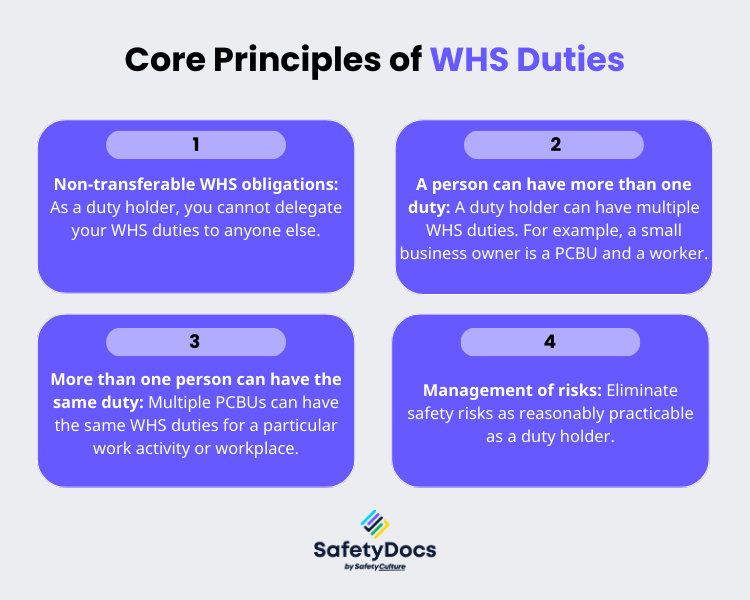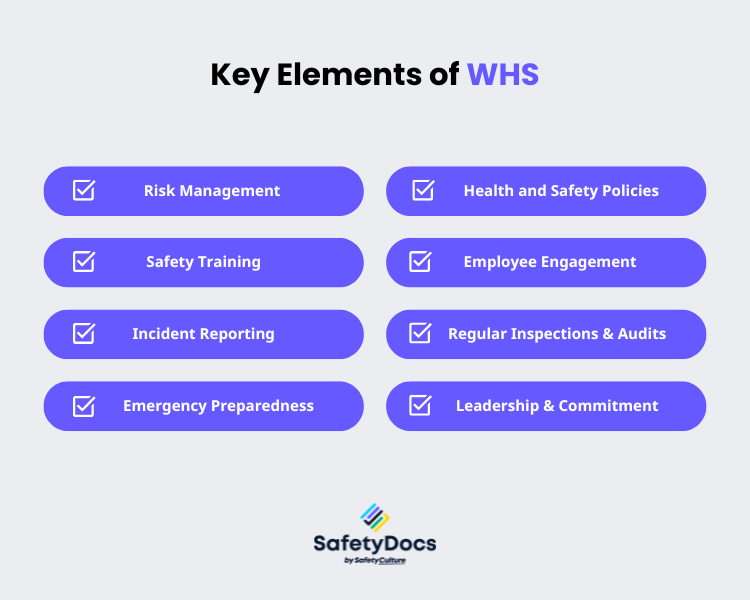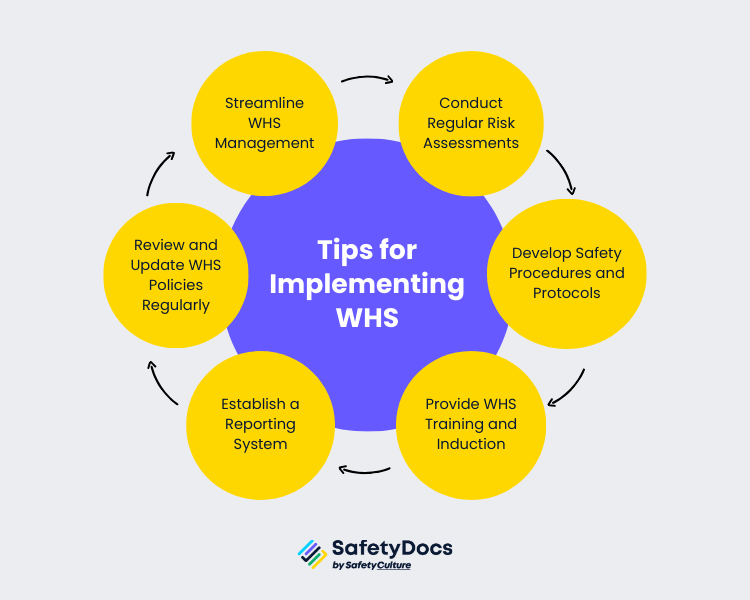Safe Work Australia runs ‘National Safe Work Month’ every October. It's a time when employers and workers across the country are encouraged to commit to creating safe and healthy workplaces. The 2024 theme is ‘Safety is everyone's business’. By everyone, it also includes small businesses, who may not have the same resources as larger companies. However, they are still responsible for providing a safe working environment for their employees. Not only is it the right thing to do, but it also makes good business sense. Implementing WHS fundamentals is key to achieving this goal.
This blog will discuss the importance of WHS for small businesses, key principles to remember, and practical tips for creating a safer workplace.
What is WHS
Work Health and Safety (WHS), also known as Occupational Health and Safety (OHS), is an Australian framework that describes the efforts made to ensure workers' physical, mental, and social well-being while at work. WHS aims to prevent work-related injuries, illnesses, and fatalities by promoting safe work environments and practices. Workplace incidents can have significant human and economic costs, affecting employees and employers. Understanding these impacts is crucial for fostering safer work environments and mitigating potential liabilities.
Human Costs of Workplace Incidents
According to the International Labour Organization (ILO), every year 2.6 million people die from work-related causes globally. As of August 29, 2024, the Preliminary Fatalities report from SafeWork Australia reveals that 89 workers have been killed this year. Over the past five years, the average annual workplace fatalities have been 180.
These incidents can also cause long-term psychological effects like trauma and anxiety, impacting an employee's quality of life and ability to work. Injuries and illness can also lead to lost income for the employee and their family. The emotional impact on coworkers and the workplace can lead to lower morale and productivity.
Economic Costs of Workplace Incidents
The economic repercussions of workplace incidents can be substantial for businesses. Healthcare expenses for treating injured employees can quickly accumulate, adding a significant financial burden.
Direct Costs
- Workers' compensation
- Medical expenses
- Legal fees and fines
Indirect Costs
- Lost productivity due to absenteeism or lower efficiency
- Replacement or training costs for injured workers
- Potential damage to business reputation and loss of customers
These human and economic costs highlight the importance of knowing the WHS duties for businesses, including small organisations.
Core Principles of WHS Duties
The model WHS Act establishes principles applicable to all WHS duties outlined, including the responsibilities of persons conducting a business or undertaking (PCBU). The PCBUs, safety representatives, and workers have WHS duties with the following core principles:
- Non-transferable WHS obligations: As a duty holder, you cannot delegate your WHS duties to anyone else.
- A person can have more than one duty: A duty holder can have multiple WHS duties. For example, a small business owner is a PCBU and a worker.
- More than one person can have the same duty: Multiple PCBUs can have the same WHS duties for a particular work activity or workplace.
- Management of risks: Eliminate safety risks as reasonably practicable as a duty holder.

The Primary Goal of WHS
Understanding WHS's core principles helps in understanding this framework's primary goal. The ultimate aim is to establish safe working conditions. for all workers, regardless of their job or business size. To achieve this, these two approaches are needed:
1. Reasonably Practicable Concept
‘Reasonably practicable’ in WHS means what an employer can realistically do to reduce health and safety risks. It involves balancing risk and resources to ensure effective and practical actions.
2. Proactive Approach
A ‘Proactive Approach’ to WHS emphasises preventing or controlling risks before incidents occur. This approach fosters a workplace safety culture, making it an integral part of daily operations.
Key Elements of WHS
The following elements are the fundamental building blocks to establish and maintain a safe and healthy workplace.
- Risk Management: Identifying, assessing, and controlling hazards to minimise the potential for accidents or injuries in the workplace.
- Safety Training: Providing comprehensive education and training for employees to understand safety procedures, equipment usage, and emergency protocols.
- Incident Reporting: Establishing a reporting system and analysing incidents and near-misses to prevent occurrences and improve safety measures.
- Emergency Preparedness: Develop and maintain emergency response plans to guarantee readiness for potential crises.
- Health and Safety Policies: Implementing clear policies that outline safety expectations, responsibilities, and procedures for all employees and stakeholders.
- Employee Engagement: Encouraging active participation from all staff in safety initiatives, promoting a culture where safety is a shared responsibility.
- Regular Inspections and Audits: Perform regular checks and safety audits to ensure compliance and identify improvement areas.
- Leadership and Commitment: Ensuring leadership demonstrates a strong commitment to safety, setting the tone for organisational culture and priorities.

Legislation and Regulations
Various legislation, regulations, and codes of practice govern WHS in Australia at both the national and state/territory levels. These laws are essential for enforcing work health and safety compliance, with penalties for non-compliance ranging from fines to imprisonment.
1. Model Work Health and Safety Act 2011
Australia’s WHS framework is primarily guided by the Model Work Health and Safety (WHS) Act, developed by Safe Work Australia. Each state and territory, except Victoria, has adopted its own version of this Act, with slight variations depending on the jurisdiction. The WHS Act outlines the legal responsibilities of PCBUs (Persons Conducting a Business or Undertaking), workers, and other duty holders. The WHS Act aims to:
- Protect workers and others from health, safety, and welfare harm by eliminating or reducing risks
- Ensure fair representation, consultation, and cooperation on WHS issues
- Encourage unions and employers to improve WHS practices constructively
2. Model Work Health and Safety Regulations 2011
The Model WHS Regulations complement the WHS Act by specifying the detailed requirements that must be met to ensure compliance. These regulations vary slightly by state and territory but cover essential areas such as:
- Hazardous work
- High-risk activities
- Management of workplace hazards
3. Model Codes of Practice
Model Codes of Practice provide practical guidance on meeting the standards outlined in the WHS Act and regulations. They are not legally binding but can be evidence in legal proceedings. Codes of Practice are specific to different industries and can cover areas such as:
- Construction work
- Excavation work
- First aid
- Managing hazardous chemicals
- Managing work-related stress
4. State and Territory Legislation
While most states and territories have adopted the model WHS laws, some jurisdictions have tailored these laws to meet local needs. For example, Western Australia introduced the Work Health and Safety Act 2020, which replaced the previous Occupational Safety and Health Act 1984 and brought WA in line with the national model. In contrast, Victoria has retained its Occupational Health and Safety Act 2004, which operates independently from the national model. Here are examples of WHS/OHS legislation across Australian states and territories:
- Work Health and Safety Act 2011 (NSW): This New South Wales Act aligns closely with the national model WHS laws, emphasising the duty of care for employers and workers.
- Occupational Health and Safety Act 2004 (VIC): While Victoria has not adopted the national model laws, its OHS Act similarly focuses on ensuring a safe workplace. It includes provisions for employee representation in health and safety matters.
- Work Health and Safety Act 2011 (QLD): Queensland follows the national model WHS laws and includes specific regulations for mining, construction, and other industries, reflecting the state's economic focus.
- Work Health and Safety Act 2012 (South Australia): This Act is consistent with the national model, providing a framework for safety across diverse workplaces.
- Work Health and Safety (National Uniform Legislation) Act 2011 (NT): This WHS (NUL) Act adopts the national model laws and adapts them to the Northern Territory's unique environmental and industrial conditions.
- Work Health and Safety Act 2011 (ACT): The Australian Capital Territory adopted the model WHS laws and operates under legislation closely aligned with the national framework.
- Work Health and Safety Act 2012 (TAS): Tasmania also follows the national model WHS laws, with minor adjustments to reflect local industry needs.
- Work Health and Safety Act 2020 (WA): Western Australia adopted the national model WHS laws but with specific provisions for the mining, petroleum, and geothermal sectors.
Tips for Implementing WHS
With the various regulations surrounding WHS, it can seem overwhelming for organisations to comply. But it doesn't have to be. Here are some tips for successfully implementing WHS in your workplace:
Conduct Regular Risk Assessments
Everything concerning workplace safety starts with identifying hazards and assessing their risks. Carry out regular inspections to identify hazards, assess their level of risk, and take appropriate corrective action to eliminate hazards or control them.
Develop Safety Procedures and Protocols
Create documented safety procedures and protocols that outline the steps to be followed for safe work and in case of an emergency or incident. Safety documents, such as Safe Work Method Statements (SWMS), can guide workers on safe work practices.
Provide WHS Training and Induction
Train and induct workers on all aspects of WHS, including emergency procedures, hazard identification, risk control measures, and safe work practices. This training should be ongoing for new and existing employees to equip them with the necessary knowledge and skills.
Establish a Reporting System
Create a clear and accessible system for reporting incidents and near-misses. This can be in the form of an incident reporting form or a designated person to report to. This allows for timely and appropriate action to prevent similar incidents.
Review and Update WHS Policies Regularly
Review and update your health and safety protocols regularly to incorporate new technologies, practices, and regulations. This keeps your WHS practices up-to-date and effective in protecting the health and safety of your workers.
Streamline WHS Management
Managing WHS can be time-consuming and complicated, especially for larger organisations. Consider using tools like SafetyDocs to streamline the process and make it more efficient.

National Safe Work Month: Focus on WHS Fundamentals
The first week of National Safe Work Month highlights the essentials of workplace safety, focusing on risk management, safety training, incident reporting, and emergency preparedness. These fundamentals are not just recommendations but are core to WHS regulations, which set the minimum standards for a safe working environment. Regardless of size, every organisation must integrate these essential elements into their daily operations to ensure compliance and protect their workforce.
Throughout Safe Work Month, businesses are encouraged to reflect on these foundational principles and ensure they’re being met. Engaging your team in discussions about these basics is critical to building a safety culture where everyone actively creates a safer workplace.
Supporting Your WHS Efforts with SafetyDocs
At SafetyDocs by SafetyCulture, we recognise the importance of getting these WHS fundamentals right - not just to meet regulatory requirements but to genuinely care for the well-being of your workers. We understand that WHS regulations focus on the basics to ensure that every workplace has a solid foundation of safety practices, and we’re here to help you exceed those expectations.
Contact us to learn more about SafetyDocs and how it can help your organisation with WHS management.
Our team of experts is dedicated to providing accurate and informative content. Craig Cruickshank, our senior HSEQ advisor at SafetyDocs by SafetyCulture has reviewed this blog post to ensure the highest level of quality.
Learn more about Craig's work on LinkedIn for more industry insights.
Available for instant download and supplied in fully editable MS Word format for use in your business.
Please note that the above information is provided as a comment only and should not be relied on as professional, legal or financial advice.
Share This Article
